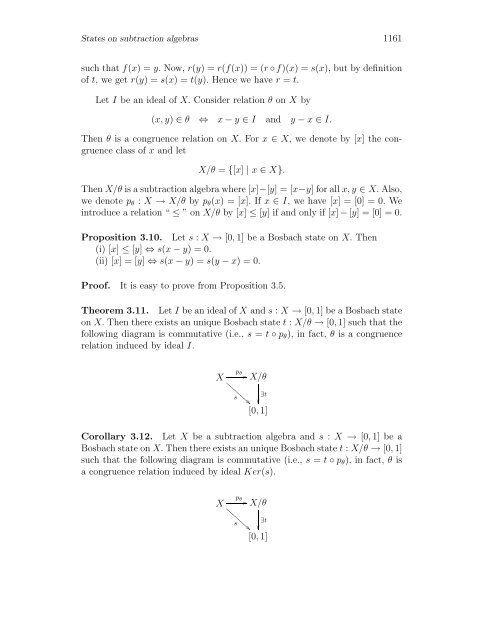States on Subtraction Algebras 1 Introduction
States on Subtraction Algebras 1 Introduction
States on Subtraction Algebras 1 Introduction
You also want an ePaper? Increase the reach of your titles
YUMPU automatically turns print PDFs into web optimized ePapers that Google loves.
<str<strong>on</strong>g>States</str<strong>on</strong>g> <strong>on</strong> subtracti<strong>on</strong> algebras 1161<br />
such that f(x) =y. Now, r(y) =r(f(x)) = (r ◦ f)(x) =s(x), but by definiti<strong>on</strong><br />
of t, we get r(y) =s(x) =t(y). Hence we have r = t.<br />
Let I be an ideal of X. C<strong>on</strong>sider relati<strong>on</strong> θ <strong>on</strong> X by<br />
(x, y) ∈ θ ⇔ x − y ∈ I and y − x ∈ I.<br />
Then θ is a c<strong>on</strong>gruence relati<strong>on</strong> <strong>on</strong> X. For x ∈ X, we denote by [x] the c<strong>on</strong>gruence<br />
class of x and let<br />
X/θ = {[x] | x ∈ X}.<br />
Then X/θ is a subtracti<strong>on</strong> algebra where [x]−[y] =[x−y] for all x, y ∈ X. Also,<br />
we denote p θ : X → X/θ by p θ (x) =[x]. If x ∈ I, we have [x] = [0] = 0. We<br />
introduce a relati<strong>on</strong> “ ≤ ”<strong>on</strong>X/θ by [x] ≤ [y] if and <strong>on</strong>ly if [x] − [y] = [0] = 0.<br />
Propositi<strong>on</strong> 3.10. Let s : X → [0, 1] be a Bosbach state <strong>on</strong> X. Then<br />
(i) [x] ≤ [y] ⇔ s(x − y) =0.<br />
(ii) [x] =[y] ⇔ s(x − y) =s(y − x) =0.<br />
Proof. It is easy to prove from Propositi<strong>on</strong> 3.5.<br />
Theorem 3.11. Let I be an ideal of X and s : X → [0, 1] be a Bosbach state<br />
<strong>on</strong> X. Then there exists an unique Bosbach state t : X/θ → [0, 1] such that the<br />
following diagram is commutative (i.e., s = t ◦ p θ ), in fact, θ is a c<strong>on</strong>gruence<br />
relati<strong>on</strong> induced by ideal I.<br />
X p θ<br />
<br />
X/θ<br />
<br />
s<br />
∃t<br />
<br />
[0, 1]<br />
Corollary 3.12. Let X be a subtracti<strong>on</strong> algebra and s : X → [0, 1] be a<br />
Bosbach state <strong>on</strong> X. Then there exists an unique Bosbach state t : X/θ → [0, 1]<br />
such that the following diagram is commutative (i.e., s = t ◦ p θ ), in fact, θ is<br />
a c<strong>on</strong>gruence relati<strong>on</strong> induced by ideal Ker(s).<br />
X p θ<br />
<br />
X/θ<br />
<br />
s<br />
∃t<br />
<br />
[0, 1]
















